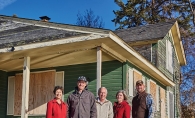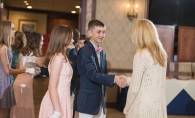The Minnesota Vikings gained a new home last summer with the completion of U.S. Bank Stadium. But the latest addition to the Minneapolis skyline has some people worried about its impact on local bird populations. Many fear the $1.1 billion structure will lead to a dramatic increase in bird deaths due to window strikes, because it’s hard for birds to see that the stadium’s massive glass windows aren’t open spaces. But an extracurricular science project by three Minnetonka middle schoolers might offer a solution.
Minnetonka Middle School West students Elena Dodd, 11, Sam Dodd, 13, and Alex Schwaller, 13, participate in the FIRST Lego League, an international science competition in which, among other things, students must create a solution to a problem around a particular theme. This year, participants were tasked with identifying and solving a problem related to human-animal interactions, and as Elena, Sam and Alex were brainstorming, the bird idea hit them—almost literally.
“We were thinking of problems that have to do with animals, and as we were brainstorming, a bird ran into the window,” Sam says. “At first we thought it was probably just normal, but we were thinking of ideas again, and another bird hit the window.” That left them wondering about how big a problem such collisions were. They discovered that in North America alone, nearly a billion birds die each year after running into glass. From there, they had both a project—how to make the U.S. Bank Stadium and its 4-plus acres of glass windows safe for passing birds—and a team name: Avian Allies.
The stadium was a clear-cut choice for the three. “It’s close to the Mississippi River, which is one of the main bird migration routes in America,” Elena explains. “So there’s going to be huge swaths of birds flying by the Mississippi River at night, and they’re not going to see the glass, so they’re going to run into it.” Originally, the team’s list of possible solutions included ideas like nets at windows to catch birds as they fall, and small white dots on the glass itself, but neither was an attractive solution, as they compromised the windows’ transparency.
Through research, they found that birds see a wider spectrum of color than people do. While the human eye filters out ultraviolet light, birds can see it clearly. That led the Avian Allies to their final idea: a UV-infused film that could be applied to the stadium’s giant windows. “Our film would be injected with UV paints so that would keep the transparency of the windows,” Alex explains. “But the birds would have a higher chance of not flying through.”
Elena, Sam and Alex’s innovative idea has an impact outside of the science competition, too. In November, they presented their research and pitched their design to the Minnesota Sports Facilities Authority, the committee in charge of the construction and operation of U.S. Bank Stadium. Although plans to make the stadium more bird-friendly won’t begin anytime soon, MSFA has issued a $300,000 study on bird fatality and told Elena, Sam and Alex that their work will be a part of it. For now, the team is busy preparing for further rounds of competition and fine-tuning their idea.
The Avian Allies advanced to the Minnesota state championships for the FIRST Lego League. At sectionals, the team won first prize for their research project, and in January, they toured 3M’s newest laboratory and met with a key scientist there about the bird-window collision issue. As of this writing, state championship results weren’t yet known; visit hightechkids.org for more info.









